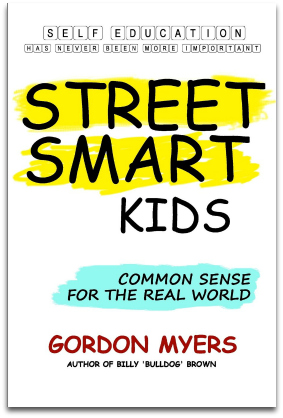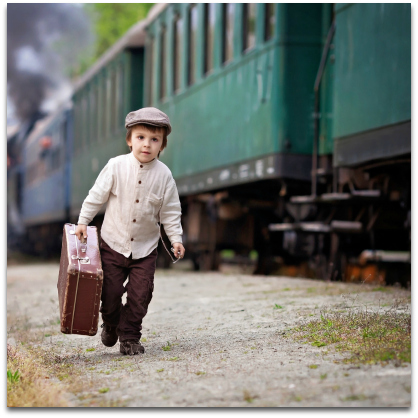 Are your children equipped to manage and make decisions when you aren’t present?
Are your children equipped to manage and make decisions when you aren’t present?
When my son was 4 years old, we had a small fire in the kitchen, and I wondered the same thing.
I was at home with him of course, but when his dad was busy trying to put the fire out and I was anxiously attempting to remove my son from the house, my son froze and didn’t know what to do.
At first, he ran back to his room to turn the television off!
Then he just looked confused and scared when I asked him repeatedly to put his coat and shoes on and step outside.
When I finally got him outside and to safety, we put the fire out and I suddenly felt like a horrible parent. We never even practiced fire drills at home, I thought to myself. If we had, maybe he would’ve known not to run back into his room and turn things off; he would have just ran for the door, I chastised myself.
But I don’t think we’re very different from other parents. Like most parents I know, I spent most of my time helping my preschooler learn the alphabet and how to spell his name. On a good day when everything was fine, practicing fire drills at home doesn’t normally cross your mind.
Yet, teaching them some of these “other” things is important.
As parents, we won’t be by our child’s side 24/7 – so, it is is crucial that we teach them how to be street smart. It’s just as important to teach them how to behave and interact with the world around them as it is to teach them how to excel academically.
Why Making Kids Street Smart is a Smart Choice for Parents
 In the book Street Smart Kids: Common Sense for the Real World
In the book Street Smart Kids: Common Sense for the Real World, author Gordon Meyers talks about how people who are street smart develop a keen sense of situation awareness that affords them a distinct advantage over others as they steer through life, and it all starts at a very young age.
Meyers also discusses how the fundamentals of learning how to fend for oneself using street smarts are mostly the same despite which type of environment kids grow up in. He believes that adults and parents have the knowledge and are in a place of power to help kids become street smart by sharing helpful tips along with their experiences and life lessons learned.
“As a coach, I was amazed at the profound effect that a little caring could have on one person, young and older alike,” Meyers said when I asked him what prompted him to write Street Smart Kids.
“The most important takeaway is that every individual is ultimately accountable for whatever happens to them in their lives. Making important and sometimes hasty decisions are quite difficult but some of them have an everlasting effect so it’s important to utilize street smarts to your benefit,” Meyers added.
As a parent, my worst fear is that I won’t be able to protect my child when he needs it. My second worst fear is that he won’t be able to protect himself and make wise decisions depending on what situation he’s in.
Helping my child become street smart solves both of these issues and helps eliminate the fear and uncertainty I once had.
Research from the Nemours Foundation supports the fact that street smart kids are far less likely to be abducted than sheltered kids. Thus, it’s in parents’ best interest to raise street smart kids who can help keep themselves safe from strangers, identify safe places in the neighborhood, and navigate their way around new places to make it through tough situations.
From Generation to Generation
 Acquiring street-smart characteristics is something we often hear about from previous generations since the concept of ‘street smarts’ dates back several decades. You’ve probably heard your parents or grandparents mention the term and it is just as important that you introduce it to your children and pass down your street-smart knowledge.
Acquiring street-smart characteristics is something we often hear about from previous generations since the concept of ‘street smarts’ dates back several decades. You’ve probably heard your parents or grandparents mention the term and it is just as important that you introduce it to your children and pass down your street-smart knowledge.
Growing up, I always thought of my dad as the epitome of a street-smart person and come to find out, he developed his sense of situational awareness (not to mention common sense) as a child. My dad learned from the school of hard knocks when his father dropped him off in the downtown area of Chicago and challenged him to find his way back home on his own.
This was in the ‘60s mind you, and a little tough in my opinion. It’s certainly something I would never do to my child today but my dad accepted the challenge and returned home in one piece.
Ever since then, he’s become a reliable human map of the city and it’s almost impossible for him to get lost. He literally knows every nook and cranny throughout the entire city including the suburbs of Chicago. There’s not a street or area he doesn’t know about and if I ever needed help or directions all I’d have to do is call him and he’d know where I was. It’s very impressive.
He taught me how to be observant of my surroundings at all times. It’s a valuable trait that can not only help ensure my safety but the safety of my child as well.
From teaching your kids the basics about not talking to strangers and avoiding dark abandoned alleys at night to equipping them with navigational skills and wise personal instincts, there are plenty of effective ways we can help our children become street smart as they grow up.
Age-Appropriate Ways to Help Our Children Become Street Smart
Birth to 5

- Read them books about the world around them.
- Teach them not to walk or play in the street.
- Get them comfortable with using the phone to dial 911 in the case of an emergency.
- Make up a song to help them memorize their phone number.
- Teach kids their address or just your street name and city.
- Define who strangers are without making them feel afraid (utilize this downloadable strangers book created by the Global Children’s Fund or something along the lines of this Berenstain Bears book
).
- Plan a field trip to the local police station or fire department so kids can see the uniforms that these officials wear and become more comfortable with who they are and what they do.
- Reward and treat your kids when necessary and encourage them not to take any candy or treats from a stranger without your permission.
- Practice ‘what if’ scenarios and tell kids what they should do if you ever become separated in a public area.
- Let your kids get outside and play with your supervision. There’s no way they can learn how to interact with other people and navigate through the world if they don’t get out and explore it.
- Help your kids identify physical characteristic of people like hair color, eye color, tall or short etc. This will help them be able to identify/describe someone should they ever have to.
- Play memorization and recognition games with your kids like Memory or Guess Who, then take the elements of the game out into the real world and ask them questions about people and places you visit so they can recall what they remember.
Ages 6-10

- Encourage kids to stay, play, and travel with a group of friends.
- Have kids memorize the phone number of one family friend, or nearby relative who can help if you’re not available.
- Develop routines for fire drills, tornado drills etc.
- Rent safety videos from the library and have a movie night with snacks and talk about what your child saw and learned from the video afterward.
- Teach kids about how traffic signals work and basic traffic signs so they can cross the street properly, alone if needed.
- Don’t allow them to answer the door for anyone without your permission, even if it’s a familiar face. Keep this rule consistent.
- Take your kids on a tour of their neighborhood and the downtown area.
- Establish a secret code word with your child. If someone comes to pick your child up, they must recite the code word, or your child shouldn’t go anywhere with them. Change the word as needed and practice every week.
- Teach them what to do if you were to get injured or hurt. (This could include finding a first aid kit, calling a friend or relative, etc.)
- Practice counting money. Set up a make-believe shop with real or play money and practice buying and paying for things.
- Plan an outing that involves taking public transportation with your kids to get them familiar with that setting in case they have to use it one day.
- Visit a museum and let your child play tour guide. Instead of grabbing the map and organizing the visit, let your child take the lead and navigate your family through the facility. This will help them learn how to use directions and navigate through crowds of people.
- Identify all major roads and highways and how to get them.
- Revisit the police station and the fire department so your child can meet and talk to these officials, and they can explain to them what they do and how they can help in various situations.
- Continue going over ‘what if’ situations but also role play with your child to ensure they understand the protocol you’ve laid out for various different situations.
- Consider putting your son in Boy Scouts or your daughter in Girl Scouts to help give them life skills pertaining to establishing healthy friendships, creating solutions to problems, survival skills, setting goals, and being a team player.
Ages 11-14

- Give your kids tips for how to use their best judgement and avoid spending time with questionable people.
- Practice teaching your kids how to be observant and aware of their surroundings by playing memory games when you are outside or in the car to see what they remember about various settings.
- Teach your kids how to use the Internet properly and about hackers and online predators.
- Make sure your child has a cell phone by this age so they can contact you.
- If your child walks to school or takes the bus, make sure they are free from distractions in order to observe their surroundings.
- Give them practical options for dealing with bullies that won’t risk their safety and wellbeing. This includes walking away from someone who is taunting or making fun of them and not challenging that person or escalating the situation. There are always teachers, counselors, and other school officials who can handle the situation best.
- Take your kids out into various communities to volunteer and interact with other people outside of their neighborhood.
- Teach your kids how to say ‘no’ to anyone acting inappropriately regardless of their position of power.
- Encourage kids not to get in the car with anyone they don’t know even if it’s a friend’s friend.
- Teach your children about the features of different car makes and models so they can recognize them.
- Enroll your child in a local or school prevention program.
- Travel with your kids and allow them to explore different cultural norms.
- Let them go to summer camp, even if it’s just for a few weeks, to gain more life skills and conquer a different setting.
15 and up

- Warn your teens about choosing their friends wisely. Association brings assimilation.
- Teach your teens how to bargain and negotiate in case they need those skills someday.
- If they go out to a party or event, encourage them not to set their drink down and leave it.
- Teach them to be observant and aware, establish trust so they can feel comfortable coming to you with anything.
- Visit scam websites with them and watch shows like American Greed together to learn more about common scams.
- Watch the news with them in the morning, not to scare them, but to make them aware of various scenarios and what’s going on in their neighborhood.
- If they transport themselves to school, work, or an extracurricular activity, switch up their schedule by dropping them off or taking a different street on random days. This could throw any predators off who are looking to bother someone with a predictable schedule.
- Don’t shelter teens; teach them about different people and situations before the world teaches them.
- Require them to communicate their whereabouts with you at all times and give them feedback about how to make the best decisions in each circumstance. You shouldn’t have to wonder where they are or what they’re doing.
I’m grateful that my mom never sheltered my older sister and me when we were growing up. When we were old enough to know something and learn about an experience she had, she didn’t hold back from telling us. In turn, it made us wiser, more observant, and able to confidently make the right choices.
Sheltering kids too much just puts them in an unrealistic bubble and doesn’t prepare them to deal with various different situations when they occur. I fondly remember car rides that were spent going over safety tips and experiences that my mom encountered.
Now that I’m a mom, I use car rides to converse with my son about experiences and ideas that he can grasp at his age. I point out the police station when we pass it, safe places and unsafe places, and familiar landmarks in the area. When it comes to your child learning how to become street smart, you are that link between home life and the real world. Grab the everyday teaching opportunities every chance you can!
Two Minute Action Plan For Fine Parents
Ask yourself: What does my child know how to do well? Does he or she pay attention to the world around them? What situations can they handle without my guidance? What situations do they need to learn how to handle if I’m not present?
Have a serious but friendly sit-down conversation with your child. Introduce the concept of being street smart and communicate its importance.
Make sure they are comfortable calling 911 in the case of an emergency and know their phone number. If your child is older, teach them the phone number of a trusted friend who can help in an emergency.
The Ongoing Action Plan For Fine Parents
Practice setting up routines that will help your children manage when unexpected events and situations occur. Organize a fire drill and a tornado drill routine to start and identify safe places in the home. Then develop a plan with your child that will help them know what to do if you were ever separated from each other in a public area.
Train your kids how to be aware of their surroundings when they are away from you and give them a tour of your area and neighboring towns so they can become familiar with the setting.
Since being street smart is all about using the experiences and knowledge you have to make sound decisions for yourself, equip them with life experiences, insight and knowledge by getting out and exploring your surroundings together.


Thank you for this very important article. As a grandmother I have to admit I have never seen another one like it.
This is so good! Thank you! Also important for the youngest age group: make sure they know (at least) mom and dads actual names! Not just mommy/daddy.
My baby iboy s 8 months old. He was born with an under developed optic nerve, so he has little to no vision. However since a month old he would touch his index fingers together perfectly without knowing where they were. Since then he does this with all his fingers one by one. Now when i hold him, he feels for my thumb and meets it with his thumb…he also does this with all my fingers…marrying each one to his without looking….I’m amazed that he does this without thinking about it. He is quite advanced according to his milestones, besides the vision issue. What does it mean if he does this with his fingers?
Eye opening! Thank you for showing me some things I haven’t ever even thought of! Excellent article with MANY great ideas for every age!
😍
Great article! Thanks for writing it. It is something we all need to do for our children. I teach my 3 young kids (ages 7- 12) driving tips and street signs while driving, lol. They absolutely HATE it, but my 9 year old can tell you that you only turn right on red unless its posted not to, that the left lane is for passing only when there’s a dotted line, etc. Of course she rolls her eyes when someone asks.. It’s very funny! Of course it would be a lot smarter for me to practice fire drills with them! Eek, I am guilty of not teaching them street smarts and being too overprotective. I’ll take your advice and work on it. So true.
Thank you for your lovely post. I’ll be reviewing it again!
Awesome list! Thank you SO much – I totally shared this all around
Thanks Ashley! Glad you enjoyed the post 🙂
A terrific list by age range. Thank you. Kids also will realize at one point that not all adults are kind or what they appear to be. A sad lesson to learn for my 12-year-old daughter, but a realization that every child will face at one point.
Thanks for the kind words about the article, Lisa.
And ugh, about kids realizing that not all adults are kind or what they appear to be. I know what you mean about every child having to face it some day, but it still ties my stomach up in a knot when I think of my daughter facing it 🙁
That is so true Lisa. As parents we want to help our kids adjust to the real world all we can, but sometimes it can be a rude awakening.
Choncé, I like the age-specific advice you give. Considering the age of your son, you’ve got some pretty good insight for teens & up! I agree that a car is definitely the best place to have “talks” : )
Thanks Ruth! Those talk in the car work wonders 🙂
Chonce – Thank you for this post; most specifically, taking the time to list so many age-appropriate ideas. I enjoyed the story of your dad getting dropped off in downtown Chicago and having to find his way home. I bet his momma counted every minute it took him to get home!
We have an 18, 15 and 12 year-old. Our oldest lives in her own efficiency apartment about 2 miles away. While they were growing up (and even now as we are in parent taught driver’s ed with our younger daughter), we drilled street names and pointed out landmarks as we drove around town. Many times my husband would ask the kids to tell him how to get home. He’d turn whatever direction they told him, even if it was away from the house. Sometimes he let the kids work together to find their way. At times, it took us into parts of town we hadn’t ventured to recently. At other times, they did really well. It was certainly a work in progress.
Whoa, love that game Heather! I ask my daughter for directions once in a while, and if she is wrong, I correct her and make the right turn. I don’t think it registers though. Am definitely going to try this little game the next time we are driving slightly farther away from home, and see where she takes us. Seems like such a fun way to get her to learn how to find her way home 🙂
What a great post! Thanks so much. I feel so strongly about this after something that happened to my brother. He wasn’t street smart enough. Sharing!
Ouch. Sorry about your brother, Catherine. And thanks for your kind words and for sharing!
What a wonderful list. I’ll be sharing this post.
Thanks Kristine! Glad you enjoyed the article 🙂
So glad the article resonated with you, Kristine. Thanks for letting us know 🙂